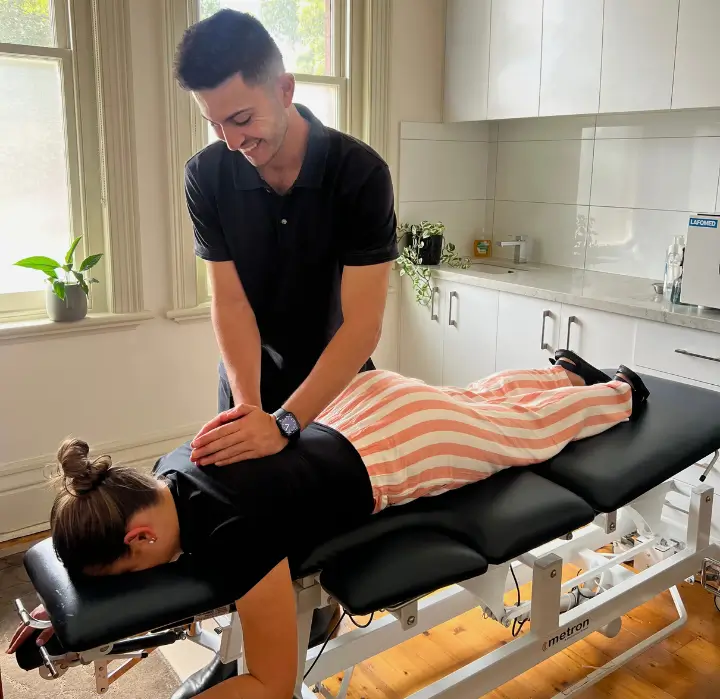Structural Balance
Osteopathy

Rated 4.9 stars from 335+ reviews
We’re thrilled to announce receiving hundreds of five-star reviews! While we’d love to share these testimonials, regulations from the Australian Health Practitioner Regulation Agency (AHPRA) prevent us from displaying patient outcomes for regulated services such as Chiropractic, Physiotherapy, Osteopathy, Podiatry, and Acupuncture on this website. To read client feedback, please visit our Google Reviews directly.
accelerate Your Recovery with comprehensive
osteopathic Care!
Osteopath
More Information Coming Soon!
5-Star Excellence
This collective is proud to showcase hundreds of heartfelt 5-star Google reviews, reflecting the unwavering dedication of practitioners to excellence and patient satisfaction. Each review tells a story of trust, exceptional care, and the meaningful connections individual practitioners have built with those they serve.
Money-Back Guarantee
100% money-back guarantee within 14 days if their service doesn’t meet your expectations, providing peace of mind on your health journey. They only take on cases where they are confident they can make a meaningful difference
Decades of Dedication
Since 1990, this collective has been a cornerstone of the community, earning trust and appreciation while joyfully supporting generations of families.
With over 65,500 patients treated, the journey is rich with stories of care, commitment, and lasting relationships.
Patient-Centric Care
In this cozy and welcoming collective hub, a spirit of inclusivity and vibrancy is celebrated. Here, humility meets excellence, and every moment is devoted to patient-centered care.
Your well-being isn’t just a priority—it’s the foundation of everything, ensuring you feel valued and supported every step of the way.
Compassionate Care
A warm-hearted approach, fueled by genuine passion, is dedicated to making a positive impact on your life.
Care and support are delivered with a commitment to not only meet but exceed expectations, ensuring a nurturing and welcoming experience you’ll truly value.
Osteopathy With a Collaborative Approach
At Brunswick Health, our independent osteopath operates their own practice, providing personalised and highly effective treatments tailored to each client’s specific needs. Their focus is on helping you achieve your health and mobility goals with dedicated, results-oriented care. As an independent practitioner, they are fully committed to your progress, knowing that successful patient outcomes are closely tied to the success of their practice. Every session is designed with this in mind, aiming to deliver the best possible results for you.
One of the key advantages of this approach is the ability to tap into the knowledge and experience of other professionals within the clinic when necessary. While your osteopathy treatment remains the primary focus, the osteopath can consult with chiropractors, physiotherapists, acupuncturists, and podiatrists if needed to gain additional insights that may enhance your care. This allows for a more comprehensive understanding of complex conditions without detracting from your primary osteopathic treatment plan.
Focusing on injury rehabilitation, pain management, and improving mobility, the osteopath’s treatments are designed to support both immediate recovery and long-term well-being. If the situation calls for it, collaboration with other practitioners is done in a way that complements your osteopathy sessions, ensuring that your care remains seamless and centred on your health goals.
This integrated approach allows the osteopath to provide highly personalised care, enriched by collaboration when needed, without shifting focus away from your primary treatment. You’ll benefit from dedicated attention and expertise, supported by a network of knowledge to maximise your recovery and overall health.
Experience osteopathy that is fully tailored to your needs, delivered by a practitioner who is deeply invested in your success and well-being, where patient outcomes are the foundation of practice success.

Osteopath Coming Soon!
Cupping
Shockwave Therapy
Osteopathy - FAQs
Browse our general FAQ for quick answers. Didn’t find what you were looking for? Give us a call or send us an email—we’re here to help!
What Conditions Can Osteopathy Treat?
Osteopathy can treat a variety of conditions, including back pain, neck pain, headaches, joint pain, arthritis, sports injuries, repetitive strain injuries (RSI), postural problems related to pregnancy, driving or work strain, and certain digestive issues.
Is Osteopathic Treatment Painful?
Osteopathic treatments are usually gentle and should not cause undue discomfort. Some people may experience mild soreness for a day or two after treatment, similar to the feeling after exercising.
How Many Sessions Will I Need?
The number of osteopathy sessions required varies depending on the condition and individual. Some people experience immediate relief, while others may need several sessions. Your osteopath will discuss a personalised treatment plan with you.
Do I Need a Referral from a Medical Doctor?
No, a referral is typically not required to see an osteopath, as they are recognised as Primary Health Practitioners and registered with AHPRA (Australian Health Practitioner Regulation Agency). This designation reflects their comprehensive training, which includes a rigorous 5-year university degree.
During this time, osteopaths acquire the necessary skills to thoroughly examine, accurately diagnose, and effectively treat a wide range of musculoskeletal conditions. Their extensive education ensures they are well-equipped to provide direct care and tailored treatments for various health issues related to the musculoskeletal system.
AHPRA manages the registration process for all qualified health practitioners, including medical doctors, surgeons, osteopaths, chiropractors, physiotherapists, and podiatrists. This ensures that all registered individuals meet the national standards for their profession in terms of education, competence, effective care, and ethical conduct. AHPRA plays a crucial role in safeguarding the quality and integrity of healthcare in Australia.
Is Osteopathy Covered by Health Insurance?
Many health insurance plans include coverage for osteopathy treatments under their ‘extras’ or ‘supplementary’ category. However, the extent of coverage can vary significantly based on the level of the policy you have chosen.
To determine exactly what your insurance plan covers regarding osteopathy, it’s advisable to contact your insurance provider directly. They can provide detailed information specific to your plan, ensuring you have a clear understanding of your entitlements and any potential out-of-pocket expenses for osteopathic services.
Can Osteopathy Help Prevent Injuries?
Absolutely, osteopathy plays a significant role in injury prevention. By improving flexibility and posture, it helps the body maintain a state of balanced mobility, similar to the suppleness often seen in teenagers.
Additionally, osteopathic treatments work to reduce muscle tension and enhance joint mobility. This combination of increased flexibility, improved posture, and relaxed muscles closely mirrors the natural agility found in younger individuals.
As a result, the body becomes less prone to the types of injuries associated with stiffness and inflexibility in adults. In essence, osteopathy helps maintain the body’s youthful resilience, reducing the likelihood of injury and keeping you more active and agile.
What's the Difference Between Osteopathy and Chiropractic?
Osteopathy and Chiropractic, both pivotal forms of manual therapy focusing on the health of the spine and musculoskeletal system, share a rich and interconnected history, as well as similarities in their approaches, despite nuanced differences.
The origins of these practices trace back to the late 19th century in the United States, with Andrew Taylor Still founding Osteopathy in 1874 and Daniel David Palmer establishing Chiropractic in 1895.
Both Still and Palmer were sceptical of the mainstream medicine of their era, which often resorted to harsh treatments. Instead, they pursued alternative approaches that emphasised the body’s structure and its crucial role in overall health.
Osteopathy, developed by Still, places significant emphasis on the musculoskeletal system’s influence on other body systems and advocates for the body’s innate healing abilities through manual manipulation and movement. Osteopaths often focus on soft-tissue techniques, affecting muscles and fascia, though this can vary based on individual practitioner style and patient needs.
In contrast, Chiropractic, as developed by Palmer, centers more specifically on the spine and nervous system, with spinal adjustments as a core treatment method. Chiropractors, like osteopaths, are trained in a broad spectrum of techniques and adapt their approach to suit individual patient needs.
While osteopathy and chiropractic have evolved as distinct practices with their own principles and techniques, their core philosophy remains grounded in the belief that the body’s structural health is key to its overall function and well-being.
This foundational belief, instilled by Still and Palmer, continues to guide practitioners in both fields, reflecting a legacy of holistic, patient-centred care that transcends their historical origins.
What's the Difference Between Osteopathy and Physiotherapy?
Osteopaths and physiotherapists are healthcare professionals specialising in musculoskeletal care, yet they bring different philosophies and techniques to their practice.
Osteopathy: A holistic five-year degree program prepares osteopaths to view the body as an integrated system, emphasising its innate healing abilities. They employ a variety of hands-on methods, such as soft tissue techniques, mobilisation, and osteopathic manipulative treatment (OMT). Osteopaths are known for their whole-body approach, often addressing lifestyle factors like posture and stress alongside the primary condition, and they possess diagnostic skills for comprehensive patient care.
Physiotherapy: Physiotherapists, trained through a four-year degree, often concentrate on rehabilitating specific injuries or conditions. Their approach includes prescribed exercises, movement training, and, at times, the use of modalities like ultrasound or electrotherapy. Typically working within collaborative healthcare settings, physiotherapists focus on restoring function and mobility, with a strong emphasis on exercise and localised treatment.
While both professions provide valuable and complementary approaches to musculoskeletal health, the choice between an osteopath and a physiotherapist will depend on the patient’s specific needs and health objectives.
At Brunswick Health, patients may choose to benefit from both osteopathy and physiotherapy, alongside chiropractic care, all under one roof. This collaborative environment prioritises patient well-being and fosters a holistic approach to healthcare.
Can I See an Osteopath If I'm Pregnant?
Yes, osteopathy is generally safe during pregnancy. Osteopaths are trained to work with pregnant women and can provide treatments to alleviate discomforts such as back pain, pelvic pain, and difficulty or pain while walking.
Is Osteopathy Safe?
Osteopathy is known for its safety and effectiveness, contributing to low insurance premiums for practitioners due to the minimal risk involved with osteopathic treatment.
As a prominent non-surgical, non-pharmaceutical healthcare profession internationally, osteopathy has gained widespread recognition for successfully helping countless individuals.
For more information and to ensure you receive care tailored to your needs, book an appointment with one of our osteopaths. We commit to accepting only those cases we are confident we can assist.
Are Osteopaths Registered in Australia?
All osteopaths are registered health practitioners. In Australia, they must legally register with the Australian Health Practitioner Regulation Agency (AHPRA), the same governmental body responsible for the registration of doctors, surgeons, and other healthcare professionals.
Additionally, governmental organisations such as WorkCover, the Transport Accident Commission, Veterans Affairs, and Medicare recognise the therapeutic benefits of osteopathy by covering treatment costs for eligible individuals under these programs.
What is the Origin of Osteopathy?
Osteopathy was founded by Dr. Andrew Taylor Still, an American physician, in the late 19th century. His personal experiences, particularly the loss of three of his children to spinal meningitis, played a significant role in shaping his medical philosophy.
Dissatisfied with the effectiveness of conventional medicine at the time, which often relied on invasive and sometimes harmful treatments, Dr. Still sought a more holistic and less detrimental approach to healing. He focused on the body’s natural ability to heal itself, emphasising the importance of the musculoskeletal system in overall health.
In 1874, Dr. Still announced the concept of Osteopathy. He believed that by correcting structural problems in the body through manual manipulation, its function could improve, and health could be restored. The key principles of osteopathy include the belief that the body is a unit, is capable of self-regulation and self-healing, and that structure and function are interrelated.
Dr. Still opened the first school of osteopathy in Kirksville, Missouri, in 1892, known as the American School of Osteopathy (now A.T. Still University). His methods emphasised hands-on manipulation, a significant departure from the invasive procedures common at the time, and promoted a holistic view of patient care.
Osteopathy gradually gained acceptance, and by the early 20th century, it was recognised in several states in the USA. Today, osteopathic medicine is fully integrated into the American healthcare system, with practitioners known as Doctors of Osteopathic Medicine (DOs) receiving medical training similar to allopathic physicians (MDs) but with an added emphasis on the musculoskeletal system and a holistic approach to treatment.
In other parts of the world, such as Australia, osteopathy is often considered a form of complementary or alternative medicine. Practitioners focus on manual manipulation techniques and are not necessarily trained as full medical doctors.
Are Osteopaths Real Doctors?
In Australia, osteopaths are recognised as allied health professionals but are not considered medical doctors.
They hold either a Bachelor or Master of Osteopathy degree and are trained in diagnosing, treating, and preventing musculoskeletal disorders. Australian osteopaths use manual therapy techniques such as stretching, massage, and mobilisation, focusing on the muscles, joints, and spine to improve health and well-being.
While osteopaths are registered practitioners under the Australian Health Practitioner Regulation Agency (AHPRA) and adhere to strict standards and regulatory requirements, their training and scope of practice are distinct from that of medical doctors (MDs).
Osteopaths in Australia do not have the same qualifications as Doctors of Osteopathic Medicine (DOs) in the United States, who are fully licensed physicians.
In the Australian context, osteopaths are qualified health professionals with expertise in musculoskeletal health, but they are not equivalent to medical doctors in terms of their training and medical practice scope.
Contact Us Today
We are conveniently located in the heart of Brunswick for easy access to all local residents.
Address: 1/68 Melville Road Brunswick, VIC 3055
Follow us on social media for the latest updates and health tips!
Areas We Serve
Brunswick, Brunswick West, Brunswick East, Essendon, Moonee Ponds, Parkville, Coburg, Carlton, Fitzroy, Pascoe Vale South, Pascoe Vale, Thornbury, Northcote.
Registered Health Providers


